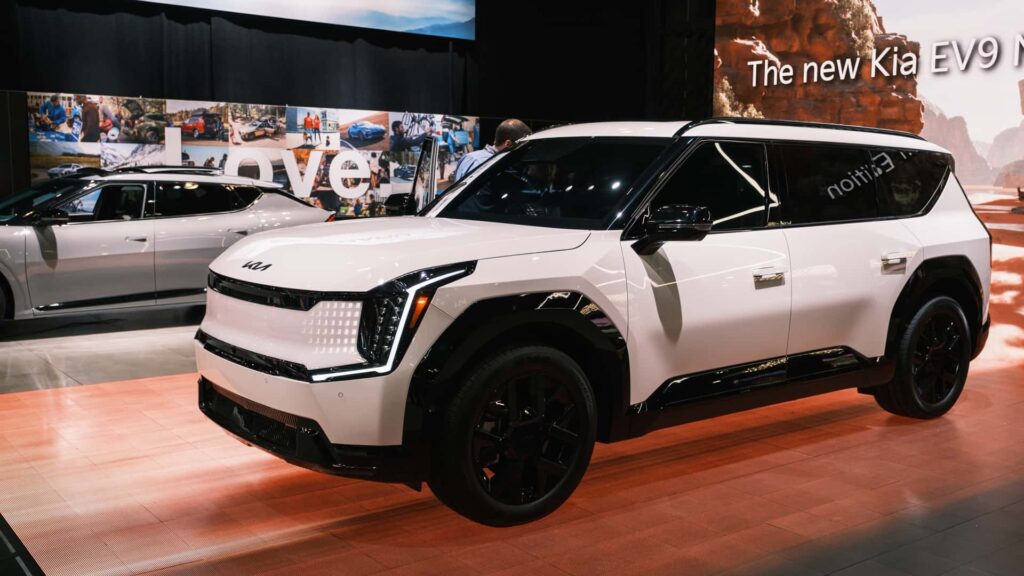The electric vehicle market has been experiencing some turbulence lately, with several factors affecting sales and production. As automakers work towards introducing more affordable EV options, tariffs have posed a challenge that could potentially hinder the availability of these low-cost vehicles. Additionally, a recent dip in EV sales in April has raised concerns among industry experts, especially after a strong start to the year.
One major factor contributing to the decline in EV sales last month was the rush by American car buyers to purchase pre-tariff vehicle inventories, with a preference for gas-powered vehicles and hybrids. This shift in consumer behavior led to a sharp drop in EV sales across various automakers. For instance, Hyundai’s Ioniq 5, Kia’s EV6, and Ford’s Mustang Mach-E all experienced significant decreases in sales, while hybrid vehicle sales saw an uptick.
Despite the overall decline in EV sales, some models managed to stand out amidst the slump. The Toyota bZ4x and Honda Prologue showed promising growth, with the bZ4x recording a 111% increase in sales compared to the previous year. Automaker officials attributed the drop in sales for mass-market electric crossovers to the production ramp-up of newer model year vehicles, causing a gap in availability on dealer lots.
Looking ahead, automakers remain optimistic about the future of EV sales. Ford, for example, anticipates a strong month for both the Mustang Mach-E and F-150 Lightning as model year 2025 vehicles hit dealer lots. Similarly, Kia is gearing up for a planned changeover to model year 2025 EV6 and model year 2026 EV9, both of which will come standard with a Tesla-style North American Charging Standard (NACS) plug.
Overall, the upcoming model years promise significant upgrades for popular EV models, including the Mustang Mach-E, Hyundai Ioniq 5, Kia EV6, and EV9. With features like NACS ports and compatibility with Tesla Supercharger stations, these vehicles are set to appeal to a wider range of consumers. If you’ve been waiting for the right time to explore electric vehicles, now might be the perfect opportunity to visit dealerships and check out the latest offerings in the market. policy to tax EVs at a higher rate than internal combustion engine vehicles is a complete head-scratcher and will likely lead to a significant consumer backlash against the Biden administration,” the firm added.
With all this uncertainty in the air, it’s more important than ever for EV owners to have reliable access to superchargers for long-distance road trips. In the past, older models may have struggled with finding compatible charging stations, but now with the availability of NACS to CCS adapters, more EV owners can enjoy the convenience of supercharging.
Having better supercharger access can make all the difference in how comfortable you feel embarking on a long journey in your electric vehicle. No longer will you have to worry about running out of battery or being stranded without a charging station in sight. With more charging options available, EV owners can now confidently plan their road trips knowing that they have the necessary infrastructure to support their journey.
As automakers continue to navigate the challenges of tariffs and price fluctuations, EV owners can take solace in the fact that they have the tools they need to make their driving experience more seamless. With improved access to superchargers, long-distance road trips in an EV are now more feasible and enjoyable than ever before.
So if you’ve been hesitant to take your EV on a road trip, now is the perfect time to give it a try. With better supercharger access and the availability of NACS to CCS adapters, you can hit the road with confidence and enjoy all the benefits of driving an electric vehicle.
Car Maker Aims to Create All-American EV with Parts Sourced from the US
In a groundbreaking move, a fictional car maker has announced plans to develop an all-American electric vehicle (EV) using only parts sourced from within the United States. While this concept may seem like a far-fetched idea, the company is determined to make it a reality, even if it takes years to achieve.
The ambitious project involves collaborating with local suppliers and manufacturers to create a supply chain that is entirely based in the US. This means sourcing components such as batteries, motors, electronics, and other crucial parts from American companies, supporting the domestic economy and reducing reliance on foreign imports.
The car maker envisions a vehicle that embodies American craftsmanship and innovation, with a focus on quality, performance, and sustainability. By utilizing locally sourced materials and labor, the company aims to create a product that is not only environmentally friendly but also socially responsible.
While the road to producing an all-American EV may be long and challenging, the car maker is committed to seeing it through. From conducting extensive research and development to establishing partnerships with suppliers, every step of the process will be carefully planned and executed to ensure the success of this groundbreaking endeavor.
As the automotive industry continues to shift towards electrification, the demand for EVs is on the rise. By introducing an all-American electric vehicle, the car maker hopes to carve out a unique niche in the market and attract environmentally conscious consumers who value sustainability and local production.
While the concept of an all-American EV may be a fictional tale at the moment, the car maker’s vision and dedication to this project serve as a testament to the ingenuity and determination of American manufacturers. With patience, perseverance, and a strong commitment to their goal, the company is poised to revolutionize the EV industry and set a new standard for sustainable transportation.
For more information on this exciting development, stay tuned for updates from the car maker as they work towards making their dream of an all-American EV a reality.
For tips or inquiries, please contact the author at suvrat.kothari@insideevs.com.

